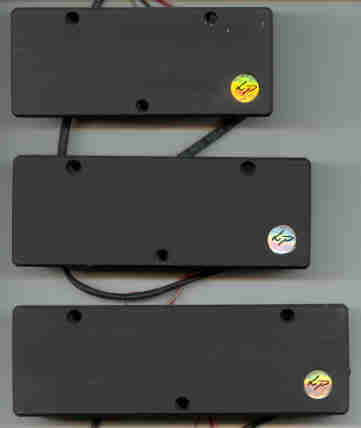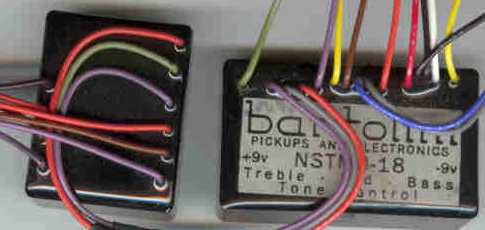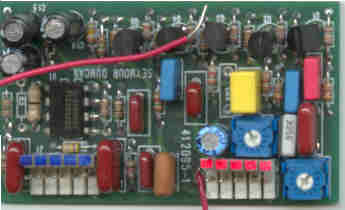|
|
||||||||||||||||
Home | The King bass | Design | Order | David King | Resources | Feedback |
||||||||||||||||
|
Use the following links to jump down to your area of interest:
The subject of pickups is a big one and it would be foolish for me to state this as final or complete guide to choosing the right pickup for your bass. Pickups are important to the sound of a bass, ranked right up there with strings as a way of defining your sound. They probably have more effect on your final sound than whatever combination of woods you choose for that perfect tone. To complicate the issue, a pickup can give quite different results on different basses. Changing strings will effect a pickup's response as well. Here is an alphabetical overview of the pickups I use regularly. Alembic: "MXY" (wide aperture) and "AXY" (narrow aperture). Using ceramic magnets and a low impedance, humcancelling winding, Alembic pickups must be combined with their active system to boost the signal sufficiently. There are two control options; either "Q" control (a sweeping, narrow band boost) or bass & treble controls. Uses 9V- 48V power supply.)
Bartolini:
"vertical hum-canceling" AKA "stacked" (lower output for use with active preamps), "linear"*, i.e., "split", "quadraphonic", "pentaphonic", "hexaphonic" etc. (A separate coil and magnet under each string or pair of strings. *These pickups cannot be mixed with other types or some strings will be out of phase, also, these pickups must be built to the exact string spacing of the instrument or the strings won't be over their respective magnets and volume will be uneven). "Dual coil", a traditional humbucker which can be wired in several ways to alter the tone. "Triple coil" is a refinement of dual coil where a dummy coil (no magnetic structure) sits between the regular coils to cancel out hum when only one of the coils is used. EMG: 4 string: "Jazz", "Precision", "P+J" combo,
"VJ","35J", "35P4", "35P", "DC35" All EMG pickups are active and require a 9V battery. All use ceramic magnets except the 4 string "VJ" which uses alnico V magnets. Some models use ceramic magnets and iron cores to warm up the tone.
It seems people either love or hate the EMG sound. I like it. These pickups always sound good to me. What's more they record well and engineers love them. If I had them in my bass I would probably hate them because they always sound exactly the same. They do pick up string movement in 2 axis which is important for slappers. They seem best suited to good old rock and roll and not much else because they are not very dynamic and don't have the extended lows of some passive models. They don't work when the battery dies. They are quiet and hum free, the "DC" line being the quietest of the bunch. I used to think the LJ5's had a nice low end but it's hard to say now for sure. Fender Lace Sensor / Actodyne: 4 string: "Jazz", "Precision", "P +
J combo".
Lindy Fralen: 4 String "Precision" and "Jazz" with alnico V magnets or ceramic magnets and steel pole pieces.
Lane Poor: (Note: Lane Poor has permanantly ceased operations and choices are limited to stock on hand.)
All with ceramic magnets, SB" denotes soap bar, "W" denotes wide aperture, "HB" denotes humbucker, These pickups are neutral sounding, they let the bass speak in it's own voice. They sound clean and accurate. The low end is tight and full with quick response. The low mids are audible so you know what note you're playing on a noisy stage. The mids aren't barky or annoying but you can coax a good growl with some eq. They pick up in the vertical axis so your slap sound is balanced and matches the volume of your fingerstyle playing. They are best suited to "bedroom" players who want a sweet, hifi sound or for recording in Jazz and New Age genres, or anywhere the bass has a lot of room in the mix Some people have experienced RF noise problems
in certain situations, the "hb" are quietest. 4 string: Vintage Jazz, Vintage Precision,
Hot"J", Hot"P", active "J" with EQ., Active "P"
with EQ., 1/4 pounder "P", 1/4 pounder "J", "Music
Man" Many different verions are available using alnico II, alnico V and ceramic magnets some with iron cores or pole pieces
Outside commentary: "I have a set of Basslines "Active five string for Jazz" (AJB-55 SET) that came stock in my Hamer Cruisebass Five. No preamp other than the one inside the pickups themselves - passive controls. These are the nicest pickups I've ever heard in my relatively brief five years on bass." -Kraig Olmstead Active Electronics: "OBP-1" Two band broad shelving +-12dB at 40Hz and 4KHz
"NSTMB-18" and "NTMB3"or "NTMB2" 18 Volts. Bass; +/-14 dB at 30Hz. Treble: +/- 16dB at 10KHz. Mid: +/- 10 dB at 250/500/800Hz switchable (NTMB3) or 260/430/660Hz switchable (NTMB2). Other mid frequency selections from 250Hz to 1500Hz can be chosen. $120
"BTC" (Bass and treble on concentric knobs with switchable treble shelving) ($80)
"BQC" (Sweepable midrange [300Hz- 3kHz] with concentric sweep and 12 db boost/cut,concentric bass and treble, switchable treble shelving) 9V to 27 volts. I recommend 18V power for all EMG stuff. ($120) Cool but unacceptably noisy, the mid band is a bit too narrow to be useful except as an effect on fretless. You can make wah-wah sounds with your free hand... "U-RETRO" Britain's John East has designed a state-of-the-art 3 band EQ system with a sweepable mid, dual input buffers and adjustable gain from 1 to 12 dB for each pickup. Includes stacked volume and blend controls (blend only works in active mode). Asymetrical treble control with center detent; (+12dB @ 3kHz, -12dB @ 1kHz ) which can be pulled up for "bright"; (+8dB @ 7kHz) stacked with boost only bass control; (+15dB @ 50Hz). Mid control; (+/- 12dB) indent at "flat" setting, stacked with frequency control; (150Hz-3KHz). Also includes active/passive switch and pickup selector switch for passive mode (switches between rear pickup and both pickups together). Uses custom plastic element pots, 3 ICs and compact, low noise components on a single epoxy insulated board. 18V power. $300 Very cool but still quite noisy. It colors the sound -treble gets muted, -bass is bigger and tighter. John is redesigning the circuit to improve the noise ratio and flatten out the response.
"2 AC" Variable10 dB boost with dual buffer, battery check light, 9V supply, 3 band eq insert point) ($125)
(Concentric bass and treble with center detents, 18dB boost, 6dB cut, switchable mid boost.) ($150)
I haven't played with these much. They have a push/pull volume switch that activates a "slap contour" which you preset inside the bass, giving you two distinct sounds. The noise floor is low at -85dB according to the specifications. The bands are narrow and preset; bass is centered at 30Hz (25Hz on the Music Man model), mid is 675Hz and treble is up at 6800Hz. The rather large circuit board uses SMT components and bulky, plug-in connectors to make it a tricky retrofit (the Music Man version is smaller). Can be by-passed for passive studio work. Runs on 9-18V. $120 |
||||||||||||||||
|
|
||||||||||||||||


